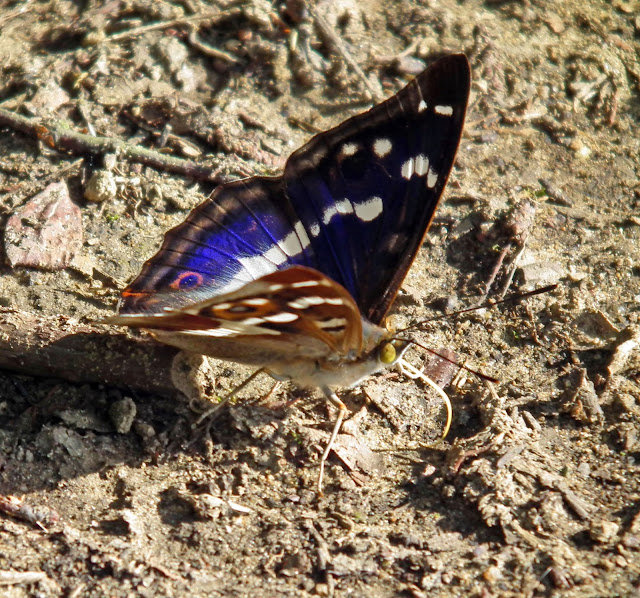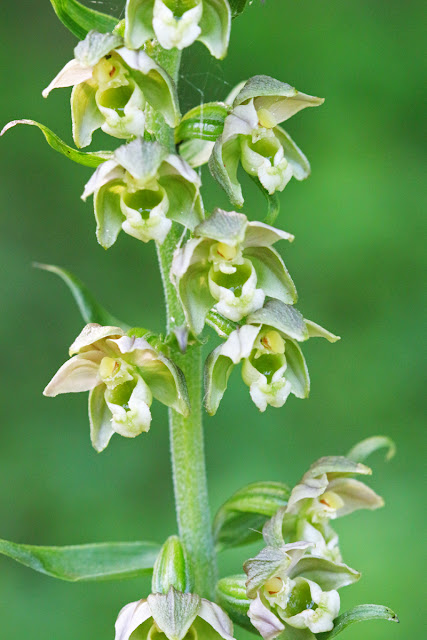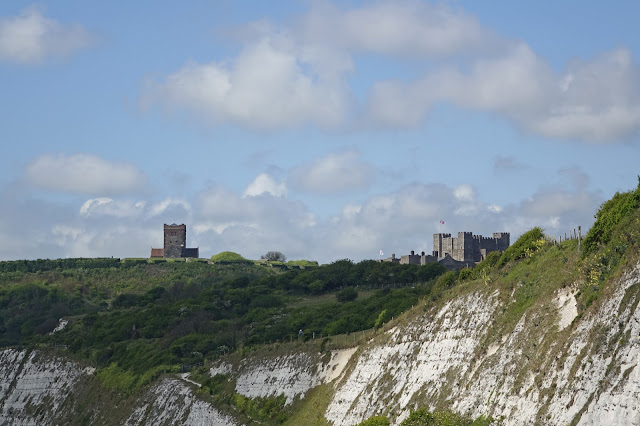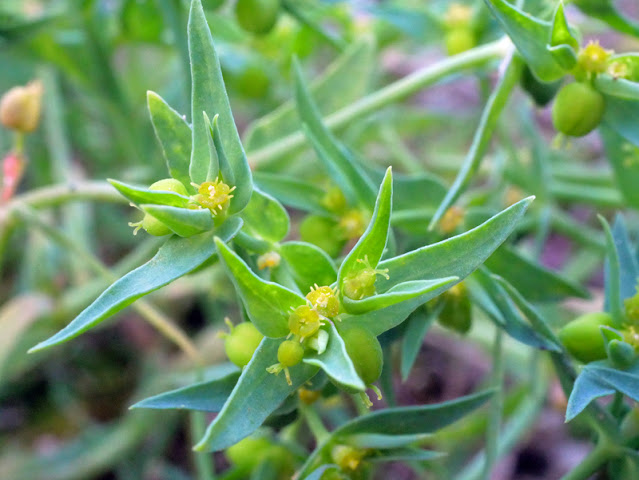Of Helleborines & Other Botanical Wonders - Kent 17-21/07/17
The end of July is the peak flowering times for Helleborines in Kent. These wild orchids can grow to three or four feet high and some can have a hundred flowers on their tall spikes.
The first trip on 17th July was to a local nature reserve at Dry Hill, Sundridge in Kent. This is close to the A21 and is renowned as a geological site, nothing much else gets a mention, but it has a big population of Broad-Leaved helleborines (for such a small reserve) and this is what I went to see there this day.
Here's one of the geological features of Dry Hill reserve, close to the entrance.
It didn't take long to find the Helleborines, they are pretty much all around the A21 side of the reserve.
Count the flowers on a plant that you can see, then double it for those behind and tou can see how many flowers one plant can produce, quite amazing really.
Here's a selection of flowers from this population in their usual form.
As ever, the sun was shining brightly giving the photos stark contrast. These plants like to grow in the shade or in semi-shade. Most had bright dappled sunlight on them filtering through the tree canopy, with much of the plant in heavy shade at the same time. This makes photography rather cahllenging. If I had time I would only visit on a bright but cloudy day to get the best photos. I've got better photos elsewhere and in previous years but that would be cheating, wouldn't it?
I found another wild orchid here, gone to seed everwhere else as had this one apart from a single flower left on top! Apologies for the rubbish photo.
Common Spotted Orchid
Dactylorhiza fuchsii
In an open area was a stand of Musk Mallow with their distinctive leaves and mallow type pale pink flowers (can also be seen in white form)
Having said about cheating with photos, I'm going to cheat now. There's an area with a wonderful display of Agrimony, Wild Basil and Meadow Cranesbill. I didn't take any photos as I had taken some I was very pleased with the year before, so forgive me for putting last year's photos in a current blog, but they're so worth a second look and the flowers are still there (as at July 17).
Agrimony (yellow flowers)
Agrimonia eupatoria
Wild Basil (pink flowers)
Clinopodium vulgare
Below is another rarity we spotted there in past years, the Purple Emperor Butterfly, not known from here either. Unfortunately I have not seen them again since at Dry Hill. These are a tree dwelling species and can be hard to spot. However, they occassionally come to the ground to lick salts from damp soil (or more often fresh dog mess) and that's the time to get your photos of them.
That's enough of cheating with my photos, back to the present (July 17).
On the way back to the car park, I was checking the Helleborines for any unusual forms when my partner found this odd looking form under the heavy shade of Beech trees. This is a first for me so was nice to see.
It's a variety lacking anthocyanin, or red pigments. In Bee Orchids this would be called "var. chlorantha" but according to Harrap's Orchids book this is:
It was the only plant there in this form, so we were lucky to find it. That ended that day's trip due to lack of time.
On the 21st July we visited some woods and a field near Holly Hill in the Snodland area of Kent, primarily to see some very rare but accidentally introduced Bean Broomrapes that have persisted here for a couple of years. Happily, nearby was a colony of Violet Helleborines as well, so two for the price of one as it were!
However, the first plant that caught my attention was neither of those, but the humble Herb Robert. This is a very common wild Geranium which is usually pink, but these again lacked colouring and were white.
What little beauties they were too. We headed into an arable field edge next to a public footpath and soon found the Bean Broomrapes. This family of plants are all parasitical on a particular host plant apart from Common Broomrape which attaches itself to a variety of hosts. In Kent I see Ivy, Common, Bedstraw (very rare) and Hawkweed Broomrapes (ever rarer), so Bean Broomrape was a first.
So, being so rare in the UK, I make no apologies for including several photos. They are a stunning looking plant, but one the farmer would rather not have in his crop I suspect. To give you some scale, check out the second photo below. There's a Common Field Speedwell in the foreground dwarfed by the Bean Broomrape.
On the way back to the woods where the Violet Helleborines were, I did notice a small arable plant worthy of a photo. The flowers on these are pale yellow and deep purple; they look like a Toadflax and in fact they are related. There's another species that is similar, the larger leaved Round-leaved Fluellen. They are often found together, but today I only found the former species.
Into the nearby woods and the Violet Helleborines were looking stunning. These grow in gloomy shade in the understory of Beech trees (usually) and rarely grow in more open conditions. They can be found in a few places in North Kent, including Shorne Country Park and in woods near Shipbourne, Tonbridge.
The first flowers I photographed were very pale.
In such dull conditions, photography was difficult, so I used a tripod and a ring flash for those interested. Without the ring flash the photos would have been very grainy and without the tripod, blurred.
Note that the leaves are not broad and elliptical on these. Also the stems are light purple to violet hued thus easily distinguishing them from Broad-Leaved Helleborines.
If you find one with features of both, it could be a hybrid, something I'd like to find in Kent.
I did find a different form a few days later but I will cover that in a future blog, keep coming back as I am adding new blogs quickly now.
Take Care
Dave
@Barbus59
The first trip on 17th July was to a local nature reserve at Dry Hill, Sundridge in Kent. This is close to the A21 and is renowned as a geological site, nothing much else gets a mention, but it has a big population of Broad-Leaved helleborines (for such a small reserve) and this is what I went to see there this day.
Here's one of the geological features of Dry Hill reserve, close to the entrance.
It didn't take long to find the Helleborines, they are pretty much all around the A21 side of the reserve.
Count the flowers on a plant that you can see, then double it for those behind and tou can see how many flowers one plant can produce, quite amazing really.
Here's a selection of flowers from this population in their usual form.
Epipactis helleborine
As ever, the sun was shining brightly giving the photos stark contrast. These plants like to grow in the shade or in semi-shade. Most had bright dappled sunlight on them filtering through the tree canopy, with much of the plant in heavy shade at the same time. This makes photography rather cahllenging. If I had time I would only visit on a bright but cloudy day to get the best photos. I've got better photos elsewhere and in previous years but that would be cheating, wouldn't it?
I found another wild orchid here, gone to seed everwhere else as had this one apart from a single flower left on top! Apologies for the rubbish photo.
Common Spotted Orchid
Dactylorhiza fuchsii
In an open area was a stand of Musk Mallow with their distinctive leaves and mallow type pale pink flowers (can also be seen in white form)
Malva moschata
Having said about cheating with photos, I'm going to cheat now. There's an area with a wonderful display of Agrimony, Wild Basil and Meadow Cranesbill. I didn't take any photos as I had taken some I was very pleased with the year before, so forgive me for putting last year's photos in a current blog, but they're so worth a second look and the flowers are still there (as at July 17).
Agrimony (yellow flowers)
Agrimonia eupatoria
Wild Basil (pink flowers)
Clinopodium vulgare
Meadow Cranesbill
Geranium pratense
Below is another rarity we spotted there in past years, the Purple Emperor Butterfly, not known from here either. Unfortunately I have not seen them again since at Dry Hill. These are a tree dwelling species and can be hard to spot. However, they occassionally come to the ground to lick salts from damp soil (or more often fresh dog mess) and that's the time to get your photos of them.
That's enough of cheating with my photos, back to the present (July 17).
On the way back to the car park, I was checking the Helleborines for any unusual forms when my partner found this odd looking form under the heavy shade of Beech trees. This is a first for me so was nice to see.
It's a variety lacking anthocyanin, or red pigments. In Bee Orchids this would be called "var. chlorantha" but according to Harrap's Orchids book this is:
Epipactis helleborine var. viridiflora
It was the only plant there in this form, so we were lucky to find it. That ended that day's trip due to lack of time.
On the 21st July we visited some woods and a field near Holly Hill in the Snodland area of Kent, primarily to see some very rare but accidentally introduced Bean Broomrapes that have persisted here for a couple of years. Happily, nearby was a colony of Violet Helleborines as well, so two for the price of one as it were!
However, the first plant that caught my attention was neither of those, but the humble Herb Robert. This is a very common wild Geranium which is usually pink, but these again lacked colouring and were white.
Geranium robertianum var. albiflora
What little beauties they were too. We headed into an arable field edge next to a public footpath and soon found the Bean Broomrapes. This family of plants are all parasitical on a particular host plant apart from Common Broomrape which attaches itself to a variety of hosts. In Kent I see Ivy, Common, Bedstraw (very rare) and Hawkweed Broomrapes (ever rarer), so Bean Broomrape was a first.
So, being so rare in the UK, I make no apologies for including several photos. They are a stunning looking plant, but one the farmer would rather not have in his crop I suspect. To give you some scale, check out the second photo below. There's a Common Field Speedwell in the foreground dwarfed by the Bean Broomrape.
Orobanche crenata
On the way back to the woods where the Violet Helleborines were, I did notice a small arable plant worthy of a photo. The flowers on these are pale yellow and deep purple; they look like a Toadflax and in fact they are related. There's another species that is similar, the larger leaved Round-leaved Fluellen. They are often found together, but today I only found the former species.
Spear-leaved Fluellen
Kickxia elatine
Into the nearby woods and the Violet Helleborines were looking stunning. These grow in gloomy shade in the understory of Beech trees (usually) and rarely grow in more open conditions. They can be found in a few places in North Kent, including Shorne Country Park and in woods near Shipbourne, Tonbridge.
The first flowers I photographed were very pale.
Violet Helleborine
Epipactis purpurata
In such dull conditions, photography was difficult, so I used a tripod and a ring flash for those interested. Without the ring flash the photos would have been very grainy and without the tripod, blurred.
Note that the leaves are not broad and elliptical on these. Also the stems are light purple to violet hued thus easily distinguishing them from Broad-Leaved Helleborines.
If you find one with features of both, it could be a hybrid, something I'd like to find in Kent.
Violet Helleborine
Epipactis purpurata
The ones below are the more usual coloured flower forms found in this area.
I did find a different form a few days later but I will cover that in a future blog, keep coming back as I am adding new blogs quickly now.
Take Care
Dave
@Barbus59



































Hi,I intend to get familiar next year with these type of wild plants,thank you,
ReplyDeleteHello Dave, thank you for your blog. We have a colony of Violet Helleborine close to us that I look after (& protect from horse riders by surrounding with sticks & branches whenever they start poking above ground in late May. These are in ancient woodland on the edge of a footpath/bridlepath between Hildenborough & Shipbourne - I was wondering if these were the same location as your photographs published here ?
ReplyDeleteHi John, I didn't publish your other comment as it included your phone number for all to see. I recall seeing a patch of Violet Helleborines on the path that runs off the A227 layby. From memory they were approximately around TQ591512 on the NW verge. Hope that helps. Dave.
ReplyDelete